Our colleagues from the Western Australian Herbarium and the WA Threatened Flora Seed Centre were featured on Perth’s 720 ABC last week. The interviews with Department of Parks and Wildlife WA, staff members Ryonen Butcher, John Huisman and Andrew Crawford, as well as Herbarium Volunteer Pat Angel, give an insight into their plant and seed collections, the care it takes to look after them, and their importance to biodiversity conservation. The two audio files can be accessed here.
Author Archives: Jürgen
Plant of the Month (though not a plant): Cortinarius austrovenetus
July’s Park of the Month, Cleland Conservation Park, commemorates renowned naturalist and mycologist Professor Sir John Burton Cleland, Professor of Pathology at the University of Adelaide. The “Plant” of the Month is not a plant but a fungus, Cortinarius austrovenetus, and is an appropriate choice since it was described by Cleland.
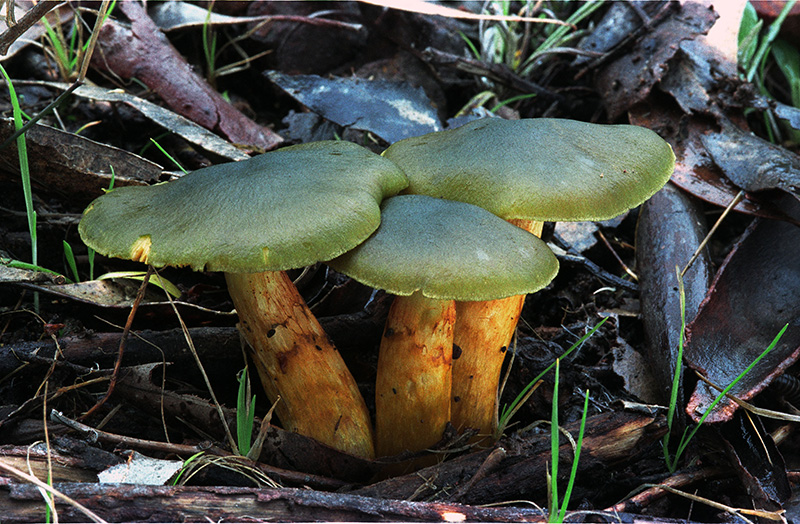
Cortinarius austrovenetus. Photo: David Catcheside.
Cortinarius austrovenetus is a handsome, medium-sized agaric, a gilled fungus. Its green, yellowish-green to bluish-green cap (pileus) may reach 80 mm diameter, is slightly domed but may become flattened. The surface is dry with a silky sheen giving it its common name of green skinhead. The gills (lamellae) on which the spores are produced are initially yellowish but become rusty-brown as the spores mature. The stem (stipe) is yellow to yellow ochre, dry and rather stout, measuring up to 80 mm in height and to 15 mm in diameter. On the upper part of the stem the remains of a cobwebby veil may have a dusting of rusty spores. The cobwebby veil is called the cortina, hence the generic name Cortinarius. It initially protects the developing gills until the spores are mature. The specific epithet is derived from the Latin auster, southern, i.e. Australasian, and venetus meaning sea-coloured. The spores are ellipsoid, measure 9 to 12 µm by 5 to 7 µm and the surface varies from warty-rough to almost smooth.
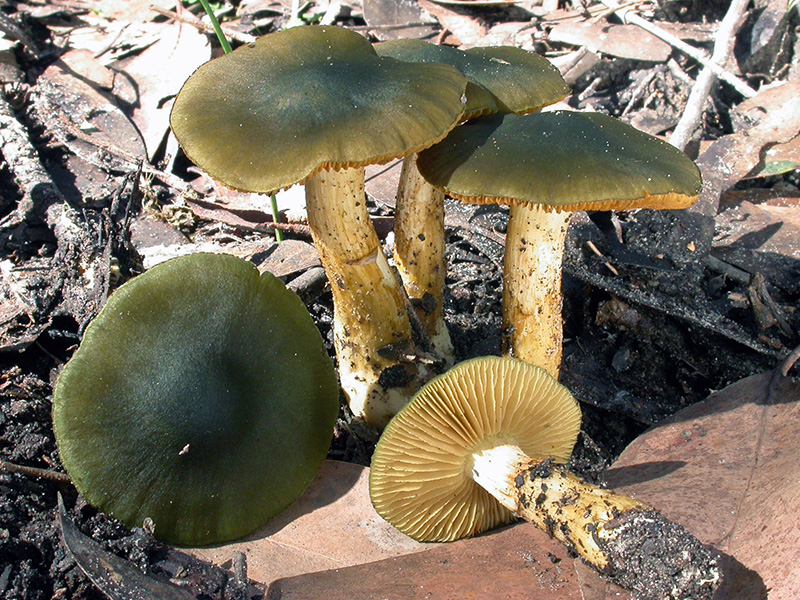
Cortinarius austrovenetus. Photo: David Catcheside.
Cortinarius austrovenetus is mycorrhizal with many species of Eucalyptus and grows on the ground in native forests and woodlands. It occurs in the southern States: Tasmania, Victoria, New South Wales, Western Australia, as well as South Australia.
J.B. Cleland collected C. austrovenetus at a number of locations in South Australia: Belair National Park, Kuitpo and Lobethal. The lectotype is from Mount Lofty. The fungus has a wide distribution in South Australia, having been found from parks on Kangaroo Island, the South-east and Northern and Southern Lofty regions, including Cleland Conservation Park.
The State Herbarium of South Australia (AD) houses J.B. Cleland’s approximately 16,000 fungal collections, over 200 of which were new species described by him.
J.B. Cleland Kt., C.B.E., M.D., Ch.M., F.R.A.C.P. was born at Norwood, South Australia in 1878. He developed a love of natural history at an early age, an interest which continued throughout his long life. He died in 1971 at the age 93.
Cleland was a polymath, knowledgeable about botany, geology, ornithology, anthropology, as well as mycology. He decided to study medicine, but, because of problems in administration of medicine at the University of Adelaide, completed his medical training at the University of Sydney. He graduated in 1900, then travelled as a ship’s surgeon to northern Australia and the Far East, went on to train in the United Kingdom in pathology, bacteriology and tropical medicine. He returned to Australia in 1905, initially to Perth, then to Sydney in 1909. While in Sydney he made many collections of fungi and collaborated with Edwin Cheel, a staff member at the Royal Botanic Gardens in Sydney. Together, they described a number of new species of fungi. Cleland returned to South Australia and was appointed Marks Professor of Pathology in 1920, a position he held until his retirement at the age of 70 in 1949.
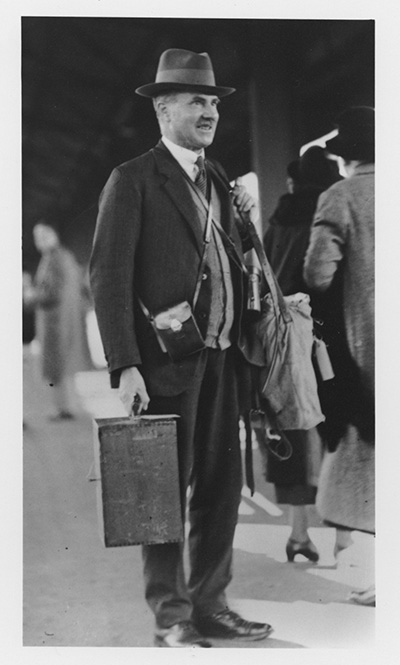
J.B. Cleland at Adelaide Railway Station with his collecting gear, 1934. Photo: State Herbarium collection.
In spite of his responsible position, Cleland devoted much time to collecting, especially to the collecting of fungi. He corresponded with mycologists around the world including E.M. Wakefield at Kew, G.H. Cunningham in New Zealand and C.G. Lloyd in the U.S.A. Most of his collections from South Australia were made from 1920 to 1935. His Handbook, Toadstools and Mushrooms and other Larger Fungi of South Australia, published in two parts in 1934 and 1935, is a major monograph on Australian fungi and the first work covering the larger fungi in this country since M.C. Cooke’s Handbook of Australian Fungi, published in 1892.
Cleland played a large part in the establishment of the Handbooks of the Flora and Fauna of South Australia and was instrumental in the publication of J.M. Black’s Flora of South Australia. He served on many semi-government committees, advising the government on matters of wildlife conservation about which he was passionate. It was largely due to his efforts that National Parks and reserves such as Belair and Flinders Chase National Parks were established.
Professor Cleland was a remarkable mycologist, naturalist, promoter of natural history and his work has enriched our knowledge and understanding not only of the mycology but of the whole South Australian biota.
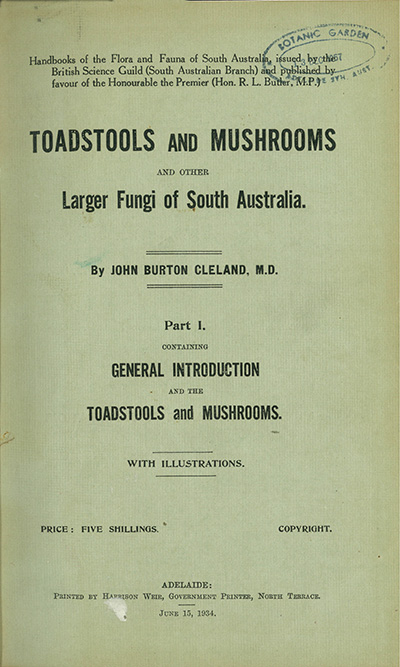 Important references to S.A. fungi
Important references to S.A. fungi
- Cleland, J.B. (1928). Australian fungi: notes and descriptions. No. 7. Transactions of the Royal Society of South Australia 52: 217-222.
- Cleland, J.B. (1934-1935). Toadstools and Mushrooms and Other Larger Fungi of South Australia, Parts I and II. Government Printer, Adelaide (Reprint 1976).
- Fuhrer, B. (2005). A field guide to Australian Fungi. (Bloomings Books: Melbourne).
- Gates, G., Ratkowsky, D. (2014). Field Guide to Tasmanian Fungi. Tasmanian Field Naturalists Club.
- Grey. P., Grey. E. (2005). Fungi down Under. Fungimap.
- Grgurinovic, C.A. (1997). Larger Fungi of South Australia. The Botanic Gardens of Adelaide and State Herbarium & The Flora and Fauna of South Australia Handbooks Committee. [An up-date of Clelands handbook].
- Shepherd, C.J. and Totterdell C.J. (1988). Mushrooms and Toadstools of Australia. Inkata Press.
- Young AM (2005). A Field Guide to the Fungi of Australia. Sydney, UNSW Press.
New journal article: June 2016
Today, the State Herbarium of South Australia published one paper in the online version of the Journal of the Adelaide Botanic Gardens.
P.M. McCarthy & G. Kantvilas, Thelidium robustum sp. nov. (lichenized Ascomycota, Verrucariaceae) from Kangaroo Island, South Australia (430KB PDF).
Patrick McCarthy (formerly Australian Biological Resources Study, Canberra) and Gintaras Kantvilas (Tasmanian Herbarium, Hobart) describe a new species of lichen from Kangaroo Island. It is only known from one locality on the island, growing on limestone amongst dense coastal heathland. The authors also provide an identification key to all species of Thelidium in Australia.
To access content of all volumes of the Journal of the Adelaide Botanic Gardens since Vol. 1 (1976), please visit the journal’s web-site at flora.sa.gov.au/jabg (the Journal is also available through JSTOR).
New water weed detected
The highly invasive water weed Myriophyllum aquaticum (Vell.) Verdc. (Parrot feather; plant family Haloragaceae) has been found growing wild in a drainage/creek line in Nairne by State Herbarium weeds botanist Chris Brodie. The small population covering an area of 2 × 2 m was discovered growing in shallow flowing water, rooted in soft silt.
Originally from South America, the species was introduced to Australia as an ornamental for aquariums and ponds, due its attractive, luxuriant growth of blue-green stems and leaves. Parrot feather grows partially submerged, with the roots, lower stem and some leaves underwater, but the top of the plant emerging above the water surface.
In cultivation M. aquaticum soon becomes dominant. The plant grows quickly and produces creeping, thickened roots (rhizomes), which produce more stems. Excessive plant material then needs to be removed and is sometimes discarded illegally on roadsides or in creeklines.
Freshly discarded plants can re-grow from a single root or stem fragments in shallow water. This aggressive growth can strongly reduce light levels and water flows, trap sediments, crowd out native vegetation and even obstruct waterways for recreational use by restricting or preventing access to the water or impeding boat passage.
Parrot feather produces male and female flowers on separate plants. So far, only female plants have been found in Australia, and therefore seeds are not produced, i.e. the plants spreads only by vegetative means. If male plants were introduced into Australia, this species could become more prolific.
It is likely that the population at Nairne is a result of dumped plant material. It is of concern because of the potential to spread. Plants are easily damaged, resulting in stem fragments breaking off and establishing in new locations downstream. With the recent and future winter rains in the Adelaide Hills, further dispersal is highly likely because of higher water levels in creeks and increased flows. The population has been reported by the State Herbarium to Biosecurity SA, who informed local NRM agencies.
Myriophyllum aquaticum has recently been suggested by Biosecurity SA to be a problem plant species (500KB PDF factsheet) and was recommended for Declaration under the Natural Resources Management Act 2004. In other States (e.g. Western Australia, Tasmania) and other countries (e.g. parts of the U.S.A., South Africa), the plant is already a declared weed. A public consultation process is currently underway and public feedback is welcomed on the South Australian Government website YourSAy.
Keeping your “eggs” in one basket
State Herbarium Hon. Research Associates Pam Catcheside and Bob Baldock report another cryptic and appealing fungus. It has appeared in the Botanic Gardens, this time amongst bark chips associated with recent plantings of pistachio saplings adjacent to the Old Tram Barn. A previous BLOG article described the coral fungus, Aseroe rubra Labill.
It is a birds nest fungus, easily passed over by the casual visitor to the gardens, but worth close inspection. Its Latin name, Cyathus olla (Batsch) Pers., literally means “cup” and “pot”. The bulk of the fungus occurs as cryptic, microscopic threads (the mycelium), infiltrating and busily dissolving the wood and bark chips for food. But the mature fruiting body is visible to the keen observer.
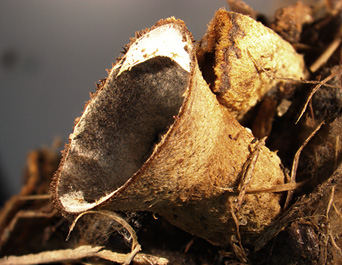
Cyanthus olla. Photo: Bob Baldock.
At first a ball-shaped structure forms. Then the membranous top tears to reveal a hollow interior with 8 to 10 grey-black “eggs” at the bottom of a fruiting body about 10 mm across which becomes goblet-shaped. The outside is grey-brown, covered with fine hairs at first, but it may later become smooth. Each “egg” is a spore packet a mere 3-5 mm by 1-2 mm, attached to the sides of the cup by fine elastic threads (unfortunately not visible in the images provided). At this minute scale, raindrops falling inside the “nest” have enough force to fling the “eggs” and their threads up and 1 m away from the fruiting body − a small-scale but violent dispersal mechanism! The elastic threads act like the boluses of South American gauchos and wrap around any available obstruction as the “eggs” land, securing them in place.
The fluted birds nest fungus, Cyathus striatus (Huds.) Willd., also appears occasionally on wood mulch in the Botanic Gardens. The cups are similar in size to those of C. olla but their outer surfaces are covered with brown, shaggy hairs, and the inner surfaces are grooved or fluted, hence the name striatus.
Other birds nest fungi, Nidularia and Crucibulum species, lack elastic threads and have their “eggs” embedded in mucilage, but like Cyathus, rely on raindrops for dispersal.




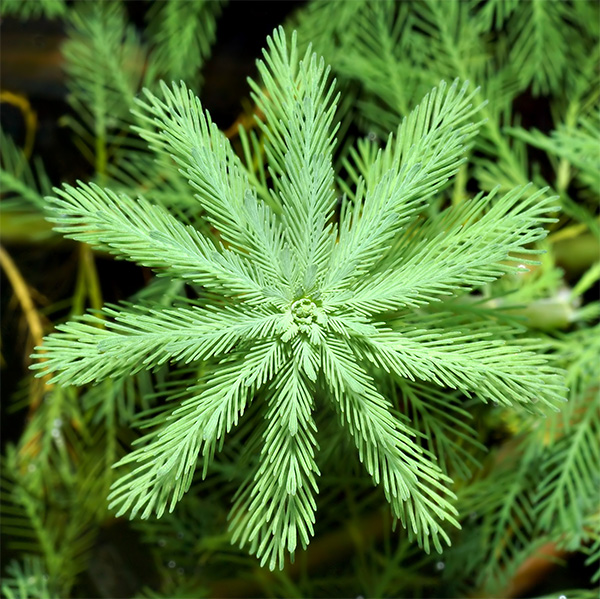

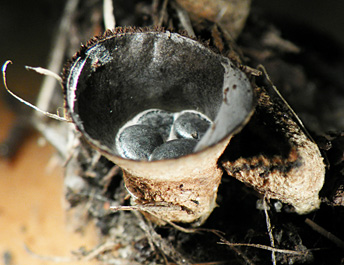

You must be logged in to post a comment.